This post takes a look at the planning application for a proposed distillery, visitor centre and warehouse in the conservation village of Luss submitted on 11th August by the Hay Partnership on behalf of Glen Luss Distillery Ltd.
The proposal
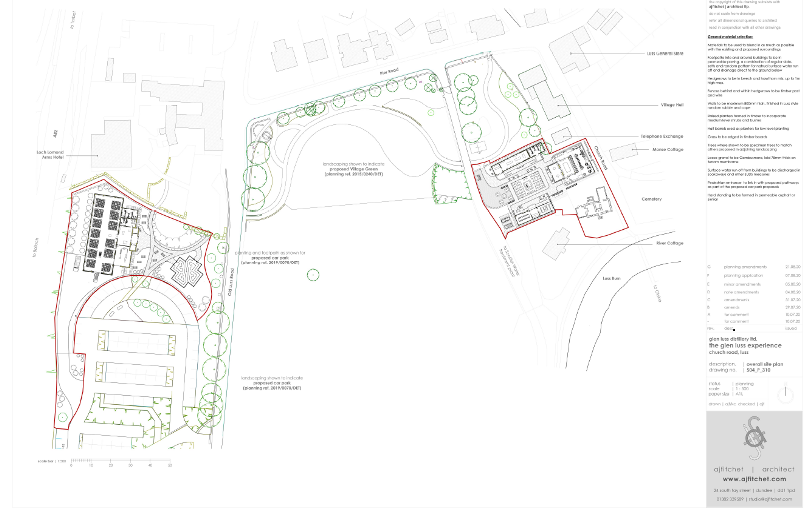
The application (see here) is in two parts. The first, the area in red on the right of the plan, involves converting and extending the former smokehouse to form a distillery and “learning centre”, extending the existing retail unit so that it can also include a “tasting and make your own gin or rum facility” and erecting a new building to provide a “Discovery Centre” on the site of two metal storage units and six outdoor air cooling units. All three buildings will face onto a new courtyard dominated by a freestanding covered area where food and drink “might be made available” (hedging their covid bets?). The neighbouring Dell Cottage will be converted into an office.
The second part of the proposal, on the left of the plan, is to create a warehouse and retail unit called “The Cask and Bottling Experience” and erect a greenhouse that will utilise some of the waste products from the distillery. This is linked to a large new car park on the south of the village.
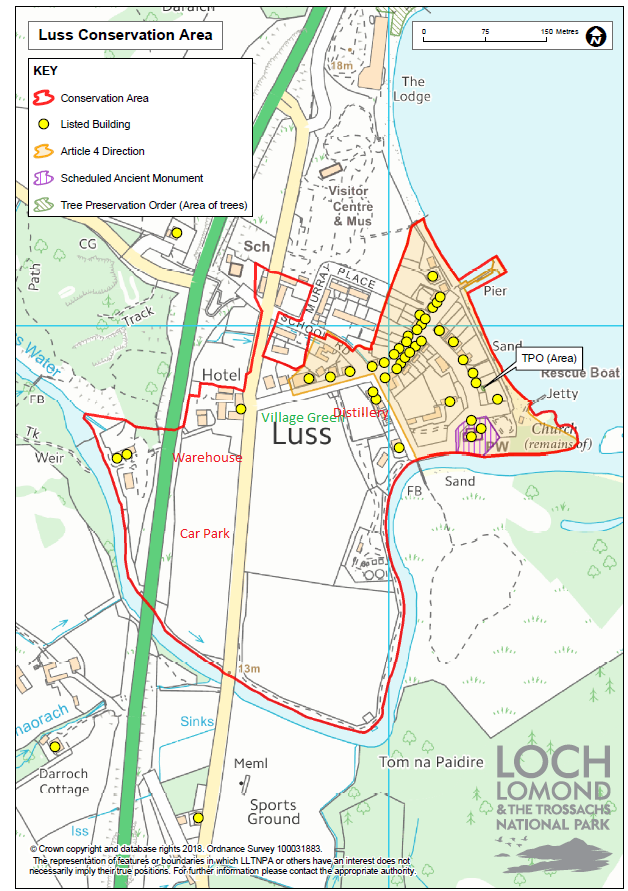
Extract from draft Luss Conservation Appraisal, which is not referred to in the planning documents, annotated to show the location of the proposed development within the conservation area
Development history
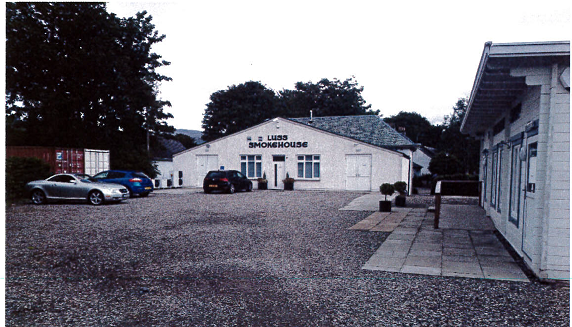
In 2014 the Loch Lomond and Trossachs National Park Authority granted planning permission to Sir Malcolm Colquhoun, the laird, to build a fish smokery together with public viewing area on the site of the old telephone exchange in Luss. The new building was constructed without the viewing area. Two years later, in 2016, the LLTNPA regularised the unauthorised change in design by granting it retrospective planning permission (see here for planning papers). I can find no mention of the metal storage and air cooling units in either the original or amended planning applications. They should never have been allowed in a Conservation Area.
In May 2019, the Luss Estates Company, controlled by Malcolm Colquhoun, submitted another retrospective planning application, this time for a new retail unit it had erected next door to the smokery. The smokery closed in October 2019 and then, in September 2020 (i.e after the submission of the current application), Luss Estates withdrew the retrospective planning application. The current application proposes to enlarge this retail unit by eight metres to create a new tasting facility but fails to explain the existing building never had planning permission and is therefore an unlawful development. It appears the building has been slipped through the planning system with the tacit consent of the LLTNPA.
In September the LLTNPA did, however, process and approve another planning application which affects part of the site. This had been submitted back in March 2019 and was for a new 231 place car park on the south of the village (see here for papers). While its design fits like a glove with the proposed new development – except there is no provision for coaches – there is NO mention within the application or the Officer’s report that it is part of a wider development proposal. Both applications should have been considered together.
By recommending that the retrospective planning application for the shop be withdrawn, while at the same time agreeing that a green field should be converted into a car park, the LLTNPA have effectively shifted the planning goalposts. In effect, they have accepted the principle of development on both sites, making it much easier for the planners to justify further development.
Planning background
Luss was the first village to be designated a conservation area in what is now the National Park back in 1971. The conservation area was extended in 1984 but the Conservation Area Appraisal, like so many others in Scotland, has NEVER been formally adopted and is still on the LLTNPA’s to do list. Instead in 2017 the LLTNPA adopted a Rural Development Framework (RDF) for West Loch Lomond which would have been more appropriately named “A special development plan for Luss Estates”.
The RDF (see here) effectively ignored the assessment of the draft Conservation Area Appraisal (CAA) and diluted is recommendations beyond recognition. For example, the draft CAA treats the open fields to the south of the village as being integral to its character
11. OPEN SPACES
Public and private open space is important in defining the character of any settlement,
playing a key role in setting the sense of place. In Luss, there is hardly any truly private
open space, gardens are very visible from the road and tourists peer between the
houses to get a glimpse of the spaces behind.
The extent of the open fields which form the approach to the village add greatly to the
quality of the environment and act as a counterpoint to the narrow streets and enclosed
urban feeling within the main village area. It is important that this open space is retained
in its present form as a buffer zone from the busy main road to the more tranquil village
setting. The trees here are also a key feature, placed intermittently along the road side
and forming dense margins to the fields. Their influence on the general amenity of the
area and on the way views are framed, are critical to the area’s character.
The RDF reversed this by agreeing to support “additional car parking on land south of the Loch Lomond Arms Hotel in order to enhance car parking provision and reduce on street parking within the village.”
The Local Development Plan (LDP) 2017-21, approved by Scottish Ministers, envisaged no development within the Conservation Area:

However, no sooner was the LDP adopted than the LLTNPA totally undermined it through its new RDF for Luss Estates. The justification was that Luss Estates had back in 2013 developed a Strategic Development Framework. Instead of this being dealt with as part of the LDP, it was adopted afterwards, thus undermining the whole LDP process.
Luss Estates and the power of the laird
The applicant for the development, Glen Luss Distillery Ltd, was incorporated earlier this year and one might think it strange therefore that they could have been considering “introducing a distillery/visitor attraction into the Loch Lomond Area for some time“. The explanation appears to be that one of its three directors is Patrick John Colquhoun, son of Sir Malcolm, heir to Luss Estates and a previous Director of Luss Estates company, which owns all the land and buildings which will be included in the development.
The Supporting Statement to the planning application makes various references to agreements with Luss Estates but nothing about the family connection. It would appear that Luss Estates, having gained approval from the LLTNPA to develop part of Luss through the RDF, have decided to hand over responsibility for doing so to new company.
Initially it appears the Luss Distillery Company had planned to locate the warehouse on the area proposed for the Luss Village Green, despite the creation of such a green having been used in the RDF as the sweetener to justify more development in the village

Thank goodness the LLTNPA were resistant to something. Meantime the Village Green project appears no closer to happening:

Regular readers may recall that last year Luss Estates was granted planning consent for 29 new houses in eight locations (see here). There was no guarantee that any of them would be affordable, contrary to both the LDP and the diluted requirements for affordable housing contained in the RDF. The LLTNPA justified this in part on the grounds that delivery of the Village Green should count as five affordable houses:
“Finally the applicant contends that the works to provide and maintain the new village green in Luss, at an estimated cost of £137,500, would be equivalent to 5 affordable houses at £27,500 per unit. If this community infrastructure in lieu approach is accepted then this would bring the market to affordable housing ratio to 23/19 (or 55%/45%).”
Strangely, there was no legal agreement binding Luss Estates to proceed with the Village Green project which perhaps explains why the Distillery Company thought they could build on it.
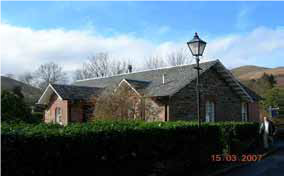
To add to Luss Estates hypocrisy on the matter of affordable housing, they are now proposing to hand over Dell Cottage, currently a residential property and a listed building, to be used as an office in the new development.
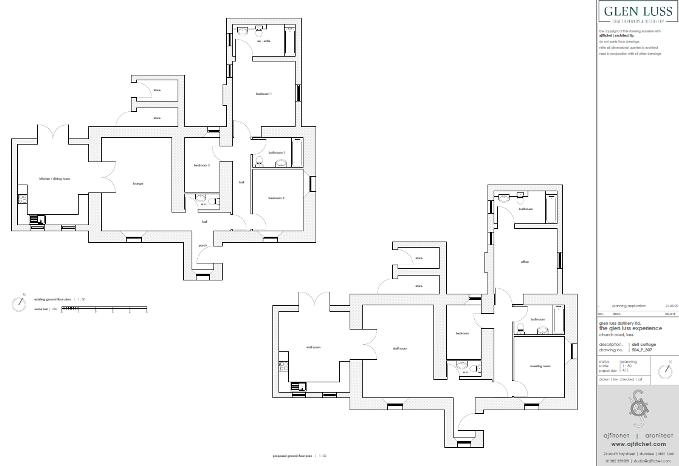
. In
The power of the laird is not limited to the influence it has over the National Park Authority, it’s also about the power it exercises as the landlord for many local people. So far there has been just one objection to this application which will potentially alter the village beyond recognition. 59 people attended a drop-in consultation event in August of whom 36 filled in a response form. 97% of those who did were in favour of the development. More interesting is why 23 people offered no comment? Why too has Luss and Arden Community Council, which strangely failed to comment on the previous retrospective planning applications, failed to respond? .Perhaps that has something to do with one of the local Community Councillors is Katharine Colquhoun who appears to be the same person as that listed as a Director of Luss Fine Foods, whose registered company address is given as the Luss Smokehouse?
None of this is to claim there won’t be some trickle down benefits to the local community. They have been promised half the space in the 15m x 15m greenhouse – that may be welcomed as anyone who has visited Luss will know its residents are green fingered – and the company has promised 5% of its initial profits (what initial means is not explained) to the local community trust fund, which may help explain why the local Community Development Trust has not responded to the application either.
The conservation issues
Luss, which has just 120 residents, sees 750,000 visitors a year making it, according to VisitScotland statistics, one of the top ten of the most popular Scottish tourist destinations, with higher footfall than Stirling Castle, the Falkirk Wheel and Edinburgh Zoo. There is a reason for that, the built environment and natural setting which are well described in the draft Conservation Area Appraisal (see here). There is a built zone, predominantly comprising cottages built out of local stone and slate, with a large green area to south which the CAA argues is integral to the attraction of the village. The development will blow a hole in both.

Luss is roofed in slate, a legacy of the slate quarries nearby, and the slate is highly visible because of the low buildings. The Planning Application discounts the need for slate roofs:

and

It is even proposed that the extension to the current smokehouse should be metal. Why was it appropriate to construct the smokehouse with slate just five years ago but not now? The Cask and Bottling Experience has been designed to look like a contemporary agricultural building. This is development on the cheap, fine for somewhere else, even in the National Park, but not in Luss.
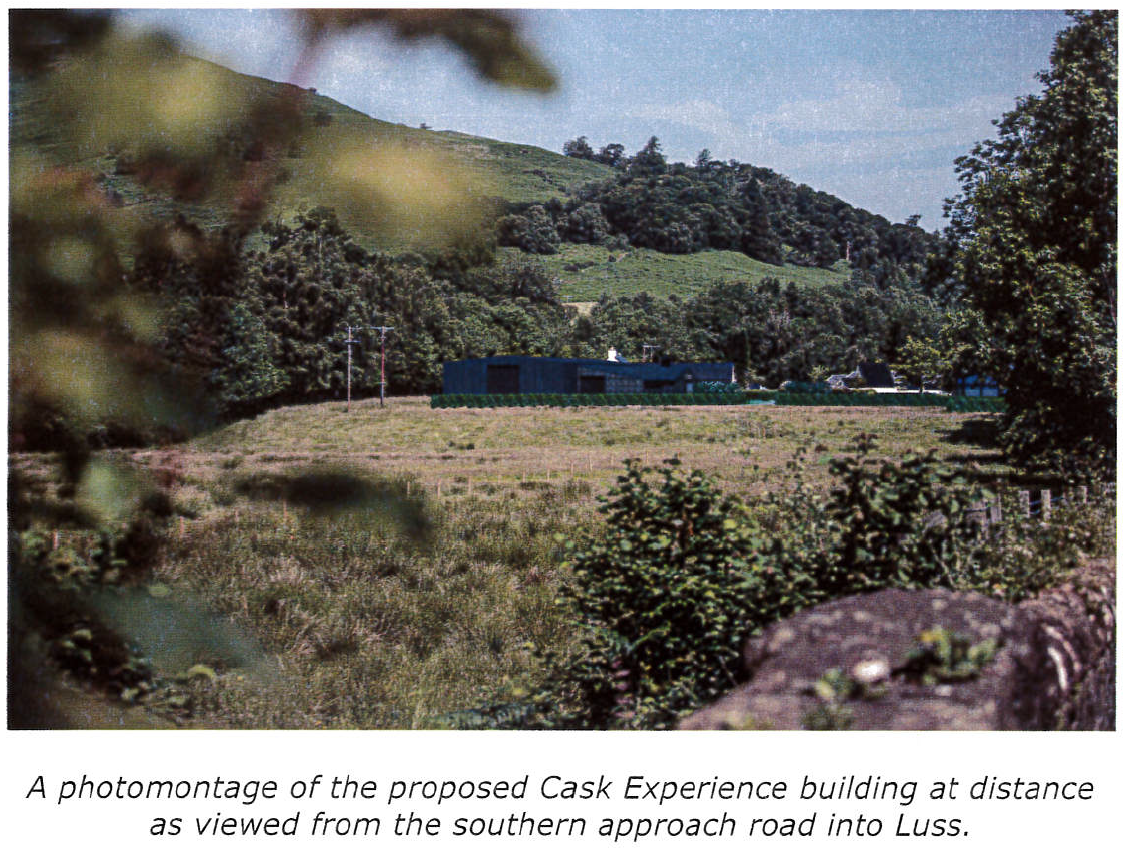
The view understates the impacts as the photomontage is shown without the large car park which will will be built on the field in the front. That will breach the green belt around the village even further and both building and car park will fundamentally alter its appearance as one approaches from the south. Instead of the village being hidden till the last moment as one approaches from the south, visitors will be “welcomed” by cars and commerce.
Visitor management issues
Luss is already overwhelmed with visitors. The situation has been made worse because there is no train station and poor bus services, so the majority of visitors arrive by car creating serious traffic and parking problems, while the LLTNPA, Argyll and Bute Council and Luss Estates have failed to work together to provide appropriate tourist infrastructure.(see here). The Supporting Statement for the planning application claims it has no intention of attracting new visitors to the village, rather the wish of the Distillery Company is to offer something more to 70,000 or so of the existing visitors. This is not credible.
The proposal to get visitors to pre-book to manage numbers will make it difficult for casual visitors to see the distillery and encourage visits specific for this purpose. While the Supporting Statement claims that Argyll and Bute’s “traffic team have confirmed that the proposed development will not generate additional traffic” actually they have lodged an objection and asked for a Transport Strategy. The proposal to offer pre-booked visitors discounts on car park charges also suggests the new car park has relatively little to do with addressing current problems within the village and everything to do with encouraging visitors into the new facility.
In these circumstances it is even more scandalous that the LLTNPA approved the creation of the large new car park (320 cars) in September. Bizarrely they claimed that this
“would assist in further enhancing the village centre’s special qualities by helping reduce the level of cars within Luss village. Luss is well connected to services, attractions and the wider countryside; therefore, the proposals can reasonably be considered to encourage a modal shift of transport for onward journeys in the surrounding area.” (see here – delegated report final)
Well connected? Only by road. Reducing traffic levels through the village? Actually, this is likely to attract more people to approach the village from the south, entering the conservation area and then driving on out to the north. A modal shift of transport? Yet more cars, the opposite of what is needed to address environmental pollution and climate change. One would have thought by now that the LLTNPA would be ruling out any new developments designed to attract visitors in the National Park unless improved public transport provision is built in.
To add to the problems, the new development will straddle both sides of what may now become the main access route into the village, adding to the mix of pedestrians, cars and commercial vehicles. Argyll and Bute Roads Department have rightly been very critical of this in their objection.
Added to which, given Scotland’s tough drink driving laws, is whether its really sensible to develop a attraction which encourages alcohol tasting? But maybe booze will only be offered to people arriving in coaches who will be forced to sober up on their walk back to the coaching parking on the other side of the village?
Flooding
The development is by the Luss Water, part is on the flood plain and at risk of 1:200 year flood events. The Scottish Environmental Protection Agency had objected to the smokehouse on these grounds, but that appears to have been ignored by the LLTNPA. Now JBA Consulting on behalf of Argyll and Bute Council (production of the flood risk appraisal appears to have been outscourced) have asked for further information on the flood risk. Perhaps the LLTNPA won’t ignore the concerns this time, with the ever-increasing evidence that flood risks in Scotland are get worse? One hopes that the insurance companies won’t be so keen to put development first.
What should happen?
The plans for a distillery, warehouse and associated visitor experience at Luss is another development which, like the Hunter Foundation Proposal at Ross Priory (see here), is in the wrong place. The reason for this is that the power to decide where developments in the countryside go lies with the landowner, not with the planning system. The sad truth is that when a laird decides the legacy of his ancestors is no longer worth preserving, that legacy can be undone in a moment.
These proposals will irreparably change the character of what is a unique conservation village. There is no other place like Luss in the National Park. Most traditional buildings and settlement in rural areas have either been bulldozed in the name of progress or improved to such an extent that they have lost their character. Luss preserves something of working class rural life from the mid-19th Century. The LLTNPA should be protecting it as part of its legal duty to conserve the cultural heritage, not bending to the whims of the current laird.
There are other places in the Loch Lomond area where such a development would be far less damaging, Arrochar or Tarbet for example, where there are better public transport connections. Unfortunately, the planning system in the National Park is totally incapable of directing development to where it is appropriate, hence the Hunter Foundation proposal at Ross Priory while the outdoor centre at Ardlui falls into disrepair.
If you want to object to the application you can do so here. Objections are more likely to be taken seriously if they refer to current National Park plans and policies. Among those relevant to consideration of the proposed development are the following:
- It is contrary to the Local Development Plan (see map above and here)
- It is contrary to the aims of Planning Guidance ‘Listed Building & Conservation Areas’ (see here)
- It is contrary to a swathe of the LLTNPA’s LDP policies including ‘Historic Environment Policy 2’ and ‘Transport Policy 2’ (see here for development plan policies)
- It is contrary to existing planning legislation to build on greenfield sites within a Conservation Area.
- It is contrary to the National Park Plan which has conservation and enhancement of cultural heritage at its heart with a range of policies and actions specifically aimed at enhancing the Park’s conservation areas.
